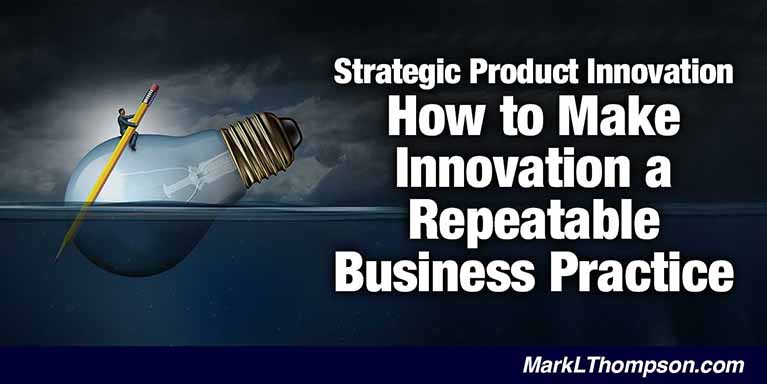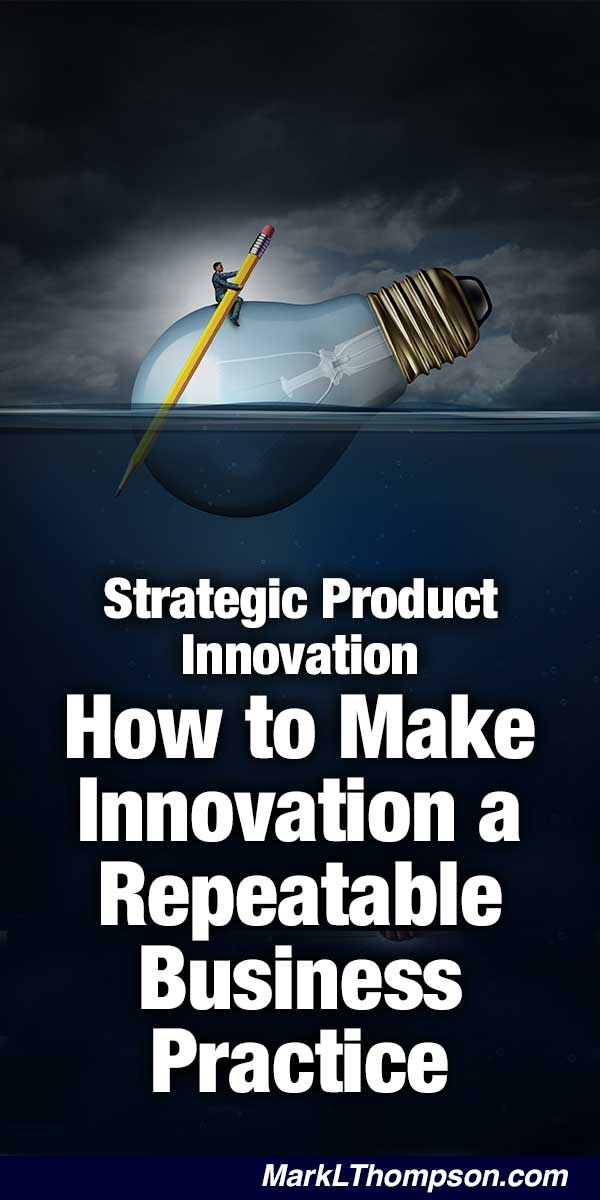I have spent years working with corporations helping them learn techniques to make their companies more competitive. I have used techniques such as Strategic Thinking, New Product Creation, and Competitive Analysis.
Most companies are so operationally focused that they miss major changes and trends that may bring them huge new strategic opportunities.
Instead, changes and trends result in a continued and repeated cycle of playing catch-up or damage control, setting the stage for self-doubt, finding blame, and personal (even corporate) failure. One cannot effectively grow a business without keeping an eye focused upon changes and potential changes the future brings.
The world’s top-performing companies share a common characteristic: Their superior ability to develop and introduce new products faster and cheaper than their competitors. As a matter of fact, effective product innovation is the key to growth – even survival – for most any business.
Some companies have the ability to introduce new products successfully at a much faster pace than their competitors and without much of a competitive response. There are companies that are able to create and introduce an ongoing stream of new products at a pace no competitor can match. Why? How are successful companies, such as Caterpillar, 3M, and Johnson & Johnson, Boeing, Skandia, Porsche, able to consistently outpace their competitors in the area of new product creation and introduction?
Part 1 – New Product Creation as a Repeatable Business Practice
Product innovation is a deliberate process and is viewed as such by long-lived, successful companies. It is an organizational skill that has been codified so that it has become a repeatable business practice known and used by everyone in the company. Product creation needs to be a constant process. The key to success is to have a deliberate process that can be made into a continuous and repeatable business practice.
The Four Steps of Product Innovation
1. Search. Innovative organizations know where to look in their environment for changes that can be converted into opportunities for new products, customers, or markets.
2. Assessment. Innovative organizations know how to assess opportunities against four key criteria to rank opportunities in terms of their overall potential.
3. Development. Innovative organizations can anticipate the critical factors that will lead to the success or failure of each opportunity. They use a stage gate type process to assess their progress.
4. Pursuit. Innovative organizations can develop an implementation plan that promotes success.
This is the process that allows the redeployment of assets and resources from areas of low yield and low productivity to areas of higher yield and higher productivity.
Part 2 – The Seven Deadly Sins of Corporate Stagnation
Why is it that companies, such as 3M, Johnson & Johnson, Google, Intel, and Merck can create and introduce a continuous flow of new products but their competitors cannot? In our search to find the answer to this question, I came across a series of self-imposed impediments that caused competitors to lag behind and, in some cases, lead them to extinction.
Sin #1. “We must protect our cash cow at all costs, or else we perish.”
Every company has a product or a market that is its cash cow. Never worship at the altar of the cash cow. You will inevitably perish. The reasoning is simple. For every employee that you train in techniques to protect your cash cow, there are 1000 people in competitive organizations thinking of ways to destroy your cash cow. And the odds are they eventually will succeed.
Once a company starts worshipping at the altar of the cash cow, its decision-making process becomes paralyzed. Once paralyzed, no new initiatives are undertaken in the debilitating interest of protecting the cash cow.
Sin #2. “Our industry is mature; there is no more growth or innovation possible.”
Some people claim the reason products become generic, prices come down to the lowest level, and growth stops is the “market is mature”. Mature markets are a myth.
The concept of mature market resides in the mind of the beholder. It is a state of mind. Management convinces itself that its business is mature and two things start to happen: First, the company stops looking for opportunities because it has convinced itself there are no more. It stops innovating. Second, the company starts diverting its resources to unrelated opportunities that take it way off course, usually with disastrous results.
There are always opportunities, particularly if one is practicing market fragmentation.
Sin #3. “We’re in a commodity business.”
Another self-fulfilling prophecy. There is no such thing as a commodity business. Commodity businesses are a state of mind as well. Your company’s products become commodities when management convinces itself that they are. The key to not allowing your products to become commodities is to practice a concept called market fragmentation.
Sin #4. “Only entrepreneurs in small companies can innovate. Large companies stifle risk taking and new product creation.”
This is a seductive fallacy which quickly becomes an impediment to new product innovation. This is particularly true in the United States because of the large number of companies that have been started by entrepreneurs and the hero worship these founders receive.
Sin #5. “Innovators are born. It’s a trait of personality, and we just don’t have any of these people around.”
One of the worst impediments to new product creation is the thought that innovation is a trait of personality. A few select people are born with that trait while the rest of the masses are not. The main reason many people attribute the skill to personality is most people who are good at new product creation cannot describe the process, or method, they use. Anything that cannot be codified cannot be explained.
The ability of people to innovate is a function of the management system in place in an organization rather than a trait of personality. They have institutionalized a process to generate, capture, evaluate, and introduce new products more quickly and more successfully than its competitors. It is the organizational process used by management that will create an environment conducive to new product innovation.
What the innovative organization requires is a process. This allows concepts for new products or markets to be gathered and harvested in a systematic manner.
Sin #6 .”New product creation is too risky.”
Although it is true new product innovation can be risky, taking extreme risk is not a characteristic of entrepreneurs nor of innovative companies. Innovative organizations do take risk, but it is a prudent risk. They know exactly what risks are there, and they have in place actions to contain such risk.
Sin #7. “We don’t have the resources necessary to innovate.”
New product or market opportunities are a function of a firm’s ability to manage change. Together with its constant strive to redeploy assets and resources from areas of low yield and productivity to areas of higher yield and higher productivity.


